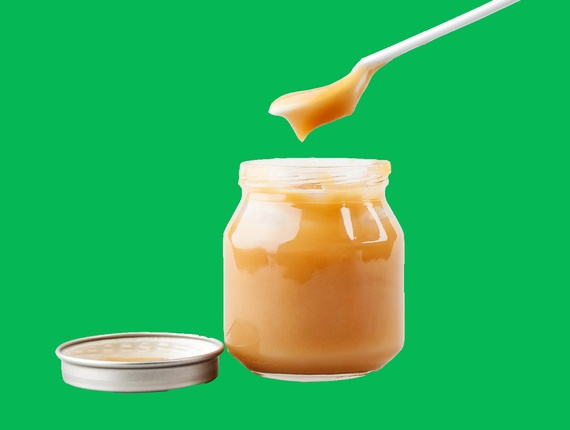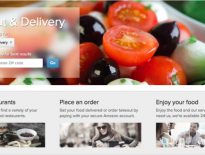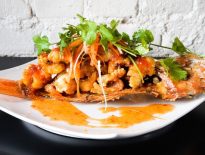American parents don’t feed their children wheat gruel and beef broth anymore—food historian Amy Bentley traces the history and science of mass-produced mashed peas.

A popular party game at baby showers involves tasting unlabeled jars of baby food and guessing at their contents, all variations on a theme of homogenously mushed plant matter. But while these adults are eating Gerber mashed peaches for laughs and baby-themed prizes, in the mid-20th century baby food was so popular that some people were cooking with recipes that used it as an ingredient.
“Baby-food manufacturers are doing what they should be doing which is trying to increase their sales, right?” asks food historian Amy Bentley, an associate professor of food studies at New York University. “They’re writing recipes that use baby food as an ingredient and sending them to women’s page editors all over the country. It’s seen as a novelty and an interesting convenience.”
After World War II, 90 percent of American babies were fed mass-produced baby food, according to Bentley’s book Inventing Baby Food: Taste, Health, and the Industrialization of the American Diet. Having secured almost all of the United States’ infant population, it seems Gerber and its cronies turned to the grown-ups.
But little glass jars of vegetable puree haven’t always been the default standard for feeding young children. In her book, Bentley traces the history of the business and science of baby food. I spoke with Bentley about how baby-food companies have adapted to different cultural climates, why what infants eat shapes their food preferences as adults, and how what people feed their children is affected by society’s conception of motherhood.
Julie Beck: Before commercialized baby food, what did people use to introduce infants to solid food?
Amy Bentley: In the United States, prior to about the 1880s, there wasn’t really a category called baby food. There was a category of soft foods that were seen as appropriate for babies, but also invalids and sick people. Also babies were not fed these foods until about 9-12 months of age, later than we feed babies now. Those foods tended to primarily be wheat gruels or beef broth, also what’s called scraped beef—very fine minced bits of beef. Beef and wheat were really seen as strength-producing foods. It was not really recommended that infants be fed fruits and vegetables until about 2 years of age. And that’s because there was a general distrust of fruits and vegetables left over from the centuries-old humoral theory of the body. But fruits and vegetables can also have a laxative effect, so that was worrisome to people. This changed in the early 1900s, when vitamins were discovered and then fruits and vegetables were seen to have real important value for adults as well as babies.
Beck: When was baby food as we know it—cans of mushy stuff—invented and popularized?
Bentley: Really in the 1920s. The first one who did it on a large scale was a man named Harold Clapp in Rochester, New York. He had a sick child and made a vegetable soup, and his child got better and people asked for his recipe. There was a canning facility in his town and so he hooked up with them and created Clapp’s Baby Food.
Gerber is getting going also in the 1920s. They are a fruit- and vegetable-canning facility in Michigan. These canners who were already canning fruits and vegetables switched to producing pureed fruits and vegetables and then marketed it specifically as baby food.
It’s very popular right from the get-go. Women are very interested in it, it’s one less job that they have to do, it gives them some flexibility, and it’s seen as scientific and modern.
Commonly Accepted Age of Introducing Solids

Beck: The typical age at which people introduced babies to solid food dropped considerably between the mid-19th and mid-20th centuries. What were the reasons behind that?
Bentley: One, it’s just available. As it’s mass-produced more and more and becomes affordable for most Americans, it becomes a viable option. Advertisers are presenting images of babies who look very young, and talking about tiny babies enjoying their peas or their mashed bananas. They’re giving visual and textual cues about the ages at which it’s okay to feed a baby. There’s also not any scientific evidence [at this time] that you shouldn’t feed young babies foods. Those studies come later. Advertisers and manufacturers, of course, are eager to have mothers introduce foods at younger ages.
The women themselves are interested in doing it. Solid food seems modern, it seems civilized, as opposed to liquid formula and breastfeeding which is characterized as primitive and uncivilized in the mid-20th century.
Beck: The later studies that said you shouldn’t feed these to young babies, what were their reasons?
Bentley: This happened so dramatically between World War II and the 1960s. The war is over, there’s amazing prevalence of these products, and a lot of postwar wealth, so people are using these products. Then, doctors and researchers begin to test these things, not only test the ages at which foods are being introduced, but also what’s in the foods that the babies are eating. Canned baby foods at mid-century are prepared the same way that all canned foods are prepared, with salt, with sugar, sometimes nitrites, MSG, preservatives, and thickener. This is how canned food is made. It’s just considered normal. Then studies come out that show that maybe high levels of salt aren’t great in adult diets, let alone children’s diets. Likewise with sugar. You’re getting the beginnings of studies showing that feeding infants solid food early on may lead to obesity later.
Beck: What cultural factors contributed to commercialized baby food’s popularity in the post World War II era?
Bentley: Well the United States emerges from WWII as one of the two superpowers—economically, culturally, diplomatically, politically. There’s enormous wealth, there’s the baby boom, and the rise of the suburbs, and commercial baby food is doing incredibly well, it’s the golden age of commercial baby food, really. About 90 percent of American infants are fed baby food. There’s this sense in the culture that we are a superpower, and commercial baby food is emblematic of that society that we are. It’s modern, it’s abundant, it’s scientific, it’s sterile. And by contrast, breastfeeding rates have been going down. They drop to incredibly low levels by the 60s and 70s. There’s this sense that breastfeeding is primitive, we don’t need to do it anymore, we can create formulas that are better than breastfeeding. Moreover, the breast becomes very sexualized, and it’s seen as something that’s private. And so formula, as well as commercial solid food, just seemed more appropriate to a rich and powerful country, post-war.
Beck: So at what point did people start to question whether it was a good idea to feed babies this stuff, and why did they turn on it?
Bentley: There were always a few lone voices in the wilderness pointing out that maybe this wasn’t a great thing. But by and large nobody really thought there was a problem with baby food at mid-century.
Then you get to the 70s, the counterculture years where everything is in question—science, institutions, government, authority. There’s the rise of the consumer movement, in which Ralph Nader and others are pressing the government to regulate companies for safety and health. And so you get the consumer backlash against the potential dangers of baby food, whether it’s unsafe jars that are out of date, or the ingredients inside them. The baby-food makers resist, some of them resist more than others, but they by and large clean up their acts. They do away with baby-food desserts, which used to be a very prevalent category, and many of them take the salt out of their products.
Beck: So there was this period in the 70s where homemade baby food was The Thing To Do—why didn’t it last?
Bentley: That was an interesting response to commercial baby food at that time. A lot of women said, ‘I’m going to make my own.’ It’s part of that 70s DIY ethos and the ethos of natural motherhood (like co-sleeping, and carrying your baby in a sling). Making one’s own baby food is another way for women to take more control over mothering and nurturing. And there will always probably be people that make their baby food, but once the companies take a lot of the offensive ingredients out, people will buy baby food. Women want mobility, they want flexibility, and baby food is an enormous convenience.
Beck: Now seems like a good time to talk about the mothers’ role in all this—how have attitudes toward processed baby food been intertwined with attitudes toward mothering and breastfeeding?
Bentley: In the early 20th century, in contrast to the natural motherhood ethos of the 70s, the ethos was scientific motherhood. So to be a good mother meant to listen to your doctor, and to trust science. It was such a difficult job that you needed to listen to the experts instead of following your own instincts.
But throughout the years has been the role of the mother-consumer, from the 20th century into the 21st. A woman’s job is to purchase things for her family. As a mother, the role of nurturer gets inextricably intertwined with the role of consumer. It’s very difficult to untangle those roles. Being a good mother means to purchase the right products, to purchase the modern conveniences, to do what the experts are saying, do what the ethos of the period is saying. We see the products change, see the advice and the practices change but that role of the mother-consumer continues today.
Beck: You’d imagine that the first food you ever eat that isn’t breast milk would have an effect on what you come to expect from and look for in food. How might the solids that parents feed their babies affect their palates and the foods they like when they grow up?
Bentley: Actually it begins earlier. Research is showing that amniotic fluid is flavored by foods a woman eats. So infants in utero are already being exposed to a variety of flavors and tastes. Breast milk is flavored—another way that an infant is learning about its environment. And if a baby is fed industrially-produced formula and food, that’s creating a narrow range of highly processed flavors that the child is exposed to, which are heavy on sugar and salt, and on the bland side.
Infants are born with a preference for sweet. Breast milk is sweet, and sweet also means “safe,” so evolutionarily it makes sense that infants have a preference for sweet because it helps guarantee our survival. We also have an aversion to bitter. It’s hard to acclimate to a bitter taste because bitter often means poison. Evolutionarily, it’s better to stay away from poison. Infants are hard-wired with some of these flavor preferences and aversions. But baby food only helped to prime their palate for a highly industrialized diet that then they might continue to consume later.
I think researchers are really finding out that it’s so important early on to expose infants to a wide variety of flavors, textures, and aromas. All of those things are educational moments. It’s almost a 180 degree turn from previous pediatric advice. When my kids were little in the 90s, the idea was you start with white rice cereal, then you introduce foods one at a time, really slowly, like one a week. You’re checking for allergies and you don’t want to put on too much at one time.
Now some researchers and pediatricians are saying that’s too slow. That’s going to take so long to introduce babies to a variety of foods. It’s just closing off their ability to learn. It takes a while for babies to become acclimated to and enjoy food; it takes 10-12 encounters. Now researchers say let’s do it faster, and if there’s an allergy stop and try to figure out what it is, but it’s more important to introduce more foods more quickly than it is to err on the side of caution.
Beck: The baby-food industry is doing pretty well today, right?
Bentley: Oh yeah. Absolutely.
Beck: How has it adapted to modern eating habits?
Bentley: The big baby-food makers are still doing fine. They are losing some market share but they have begun to adapt to the contemporary food landscape, by introducing more unique fruits, vegetables, and grains. There’s certainly the rise of startup boutique baby food, companies that have come up that are specifically making organic food with modern flavor combos. Some of these upstart companies are really giving larger baby food makers a run for their money. But the baby food industry as a whole is doing really well. One of the new factors also is the pouch, which is a new delivery system—little aluminum pouches.
Beck: Rather than jars?
Bentley: Yeah. They’re really gaining in popularity. It makes a lot of sense, it’s taking this idea of convenience and moving it a step further. These pouches are even more portable, even more flexible. You can take it yourself and squeeze it on a spoon and feed the infant, and when the infant’s old enough to grasp, you can just hand the pouch to an infant and the infant can suck on it.
Some people worry that the pouch is just going to further erode what food rules we have left about when we can eat and where we can eat. They wonder, “How are children going to learn how to bound their eating if they can suck on a pouch all the time?” But baby-food makers love it because it extends the life of baby food by about a year. Before they would assume that babies would eat their food up to 12 months. Now pouches are very attractive to parents of toddlers, so 12 months to 2 years. So it’s more than doubling the opportunity to sell a product.
Beck: Is there anything else you want to emphasize about how baby food has evolved over the years?
Bentley: It’s a product, like many products, with a series of tradeoffs. If you’re gaining convenience, you may be sacrificing control over quality, or taste, or nutrition. If you want to make your own baby food, then you’re sacrificing time. But it’s complex because a lot of women get pleasure out of making their own baby food. Just as we joke about baking cookies being a symbol of a mother’s love, well, preparing baby food can be a symbol of a mother’s love. But not all women want to do that, or not all women can do that. So I think this anxiety embedded in feeding one’s children is constant over the story of baby food.





